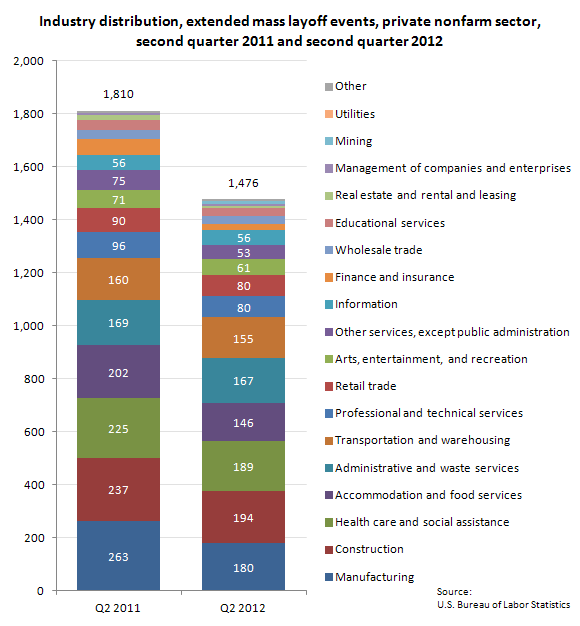August 10, 2012 (The Editor’s Desk is updated each business day.)
Extended mass layoffs, second quarter 2012
Employers in the private nonfarm sector initiated 1,476 extended mass layoff events in the second quarter of 2012, down from 1,810 events in the second quarter of 2011.

[Chart data]
Over the year ending in the second quarter of 2012, the number of private nonfarm extended mass layoff events declined in 15 of the 18 major industry sectors, with the largest decreases occurring in accommodation and food services and in manufacturing. The number of extended mass layoff events in accommodation and food services declined from 202 in the second quarter of 2011 to 146 in the second quarter of 2012.
Total manufacturing events declined over the year from 263 to 180, their lowest level for any quarter in program history (data available back to 1995). Sixteen of the 21 manufacturing subsectors experienced over-the-year decreases in the number of layoff events.
The construction sector had 194 extended mass layoff events, primarily due to contract completion. In the second quarter of 2011, there were 237 events in the construction sector.
These data are from the Mass Layoff Statistics program. Extended mass layoff data for the second quarter of 2012 are preliminary and subject to revision. For more information, see “Extended Mass Layoffs — Second Quarter 2012” (HTML) (PDF), news release USDL-12-1589. The series on extended mass layoffs cover layoffs of at least 31 days' duration that involve 50 or more individuals from a single employer filing initial claims for unemployment insurance during a consecutive 5-week period.
Related TED articles
Industry studies |
Labor force |
Manufacturing |
Unemployment
Of interest
Spotlight on Statistics: National Hispanic Heritage Month
In this Spotlight, we take a look at the Hispanic labor force—including labor force participation, employment and unemployment, educational attainment, geographic location, country of birth, earnings, consumer expenditures, time use, workplace injuries, and employment projections.
Read more »
